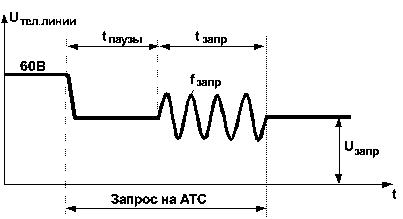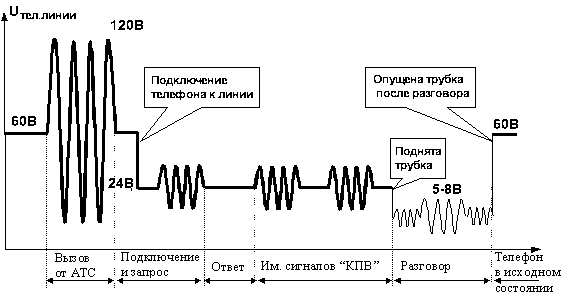Caller ID in its the work uses the following parameters signals the PBX:
- The voltage on the telephone line (hang up) - 60 To
- The amplitude of inductor call when the incoming call 50-100 V; pulse shape of the bell, the frequency - 25 Hz
- The voltage in the telephone network without the tube In 5-8
- Speed dialing 9-11 imp./with pulse coefficient dialing 1.3-1.9
- The signal "Response station - continuous tone frequency 425 Hz
- Busy signal - 425 Hz (duration and pause - 0.35 (C)
- The signal "ringback" - 450 Hz (pulse duration 1 second, pause - 4)
- The signal "lights out" - holding the tube on the lever machine with more than 1.2
The parameters of the request signal caller ID information:

- The time from Aona to connect the line to the issuance of the request (t pause) - MS 250-275
- The duration of the request signal (t req) - 100 MS
- The level of the request signal (req U) - 4.3 dB (RMS voltage of the signal of the request).
- The frequency of the request signal (f req) - 495-505 Hz
The principle of determining the number:

The subscriber PBX-1, picking up the phone, calls subscriber PBX-2. In this case, the subscriber's PBX-2 through the telephone network is fed inductor call (a call from the PBX). Phone caller ID subscriber-2 is connected to a telephone line, lowering the voltage to the level 22-24 In - blocks spoken tract. Then, using 250-275 MS (the time at the end transients when switching the telephone line) caller ID subscriber-2 gives PBX-1 signal "Request caller ID" frequency 495-505 Hz with a level of 4.3 dB and a duration 100 MS. On the ATS-1 this signal is decoded and outputted as an Answer-phone number caller PBX-1 multi-frequency method "putinterval package" in adopted code of "2 of 6". Caller ID the caller-2 receives the packet frequency the information in the order received with the subsequent decoding of the combination.

Frequency information sequence dual-frequency parcels from several frequency:
f,HzLevel, dB 700900
1100
1300
1500
1700 -6.5 to 27.4
-6.5 to 29.0
-6.5 to 31.0
-6.5 to 32.6
-6.5 to 34.3
-6.5 to 36.0
Combination two of the six frequencies above indicates the following:
f1+f2,Hz Code 2 of 6" Figure 12
3
4
5
6
7
8
9
0
"The beginning"
Repeat 700+900
700+1100
900+1100
700+1300
900+1300
1100+1300
700+1500
900+1500
1100+1500
1300+1500
1100+1700
1300+1700 000011
000101
000110
001001
001010
001100
010001
010010
010100
011000
100100
101000
"The beginning" - means the beginning and the end of dual-frequency package parcels (multi-frequency sequence is repeated several times the information package, the beginning and the end of which indicates this combination).
Repeat - means that another figure is similar to the previous (in the absence of this combination decoding of two successively following the same figures would be extremely difficult).
The information package contains 10 two-frequency parcels the duration of 38-42 MS with the following sequence of transmission:
Information is processed by the microprocessor and displayed on the indicator. Thus in the subscriber's phone-2 (Aone) signals produced by to produce a signal CPV (ringback - long intermittent beeps). Further optionally, the subscriber-2 can carry on a conversation - an algorithm for determining the Number ended.
The physical basis for the processing of multi-frequency signal
The figure shows a fragment of a dual-frequency package.

Such signal is supplied to the input of the comparator (comparison circuit), and the other input is the potential (level) comparisons. All that is above the comparison level of the comparator estimated output as a high potential, and everything below "0".
Converted to digital form, the signal is fed to the input port I / o. The Central processing unit (CPU) under the management of the program stored in ROM (read only memory), carries out a survey with some the frequency of the status of the port I / o (the state of the comparator), placing the results into a temporary memory device RAM. Then the results - the sequence of "0" and "1" recorded in the RAM for a sample (the duration of the sample depends on the size of allocated memory, so the results are not overwhelmed RAM), with the help of special programs digital analysis harmonic signal, analyzes the CPU and are identified with specific signal: the numbers 0,1-9, "start", "repeat". Working in real time, CPU the passing of one dual-frequency parcels (40 milliseconds), manages to analyze up to 5 times, thereby it is possible to compare the results, which positively affects the efficiency of identification. For lying repetition of the response, the CPU performs 50-150 such samples to obtain the unique solution: what is the category and the number of the caller.
Publication: www.cxem.net






